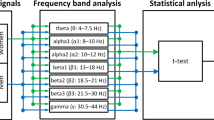We compared the characteristics of EEG in 14 men and 32 women, 18 to 21 years old, in the course of viewing neutral and emotionally (negatively, positively, and erotically) colored pictures from the International Affective Picture System (IAPS); women were tested during various phases of the ovulatory cycle. We demonstrated that changes in zonal characteristics of the main EEG rhythms related to perception of pictures of all types by men and women differed significantly from each other. In men, the EEG patterns upon the action of the above-mentioned stimuli were most similar to those observed in women during the follicular phase of the ovulatory cycle. In general, changes in EEG in the course of viewing pictures of all types were more significant in women as compared with men. For men, perception of erotically colored and negative pictures exerted greater activating effects. We found certain specificity of EEG patterns depending on the level of empathy of the tested subjects. High levels of empathy in men and women were associated with higher spectral powers of the beta and theta EEG rhythms, respectively. In women, the ability to show empathy was manifested in a different manner depending on the level of sex hormones; the presented visual stimuli could not evoke any emotional resonance in women during the follicular phase but began to evoke activation during the luteal phase.
Similar content being viewed by others
References
J. M. Goldstein, L. J. Seidman, N. J. Horton, et al., “Normal sexual dimorphism of the adult human brain assessed by in vivo magnetic resonance imaging,” Cerebr. Cortex, 11, 490-497 (2001).
S. E. Baran, C. E. Armstrong, D. C. Niren, et al., “Chronic stress and sex differences on the recall of fear conditioning and extinction,” Neurobiol. Learn. Memory, 91, 323-332 (2009).
L. Cahill, “Sex- and hemisphere-related influences on the neurobiology of emotionally influenced memory,” Prog. Neuropsychopharmacol. Biol. Psychiat., 27, 1235-1241 (2003).
B. Myers, K. Dittmeyer, and B. Greenwood-van Meerveld, “Involvement of amygdaloid corticosterone in altered visceral and somatic sensation,” Behav. Brain Res., 181, 163-167 (2007).
M. J. Weiser, C. D. Foradori, and R. J. Handa, “Estrogen receptor beta in the brain: from form to function,” Brain Res. Rev., 57, 309-320 (2008).
D. Montague, C. S. Weickert, E. Tomaskovic-Crook, et al., “Oestrogen receptor alpha localization in the prefrontal cortex of three mammalian species,” J. Neuroendocrinol., 20, 893-903 (2008).
A. A. Walf and C. A. Frye, “A review and update of mechanisms of estrogen in the hippocampus and amygdala for anxiety and depression behavior,” Neuropsychopharmacology, 31, 1097-1111 (2006).
J. M. Goldstein, M. Jerram, R. Poldrack, et al., “Hormonal cycle modulates arousal circuitry in women using functional magnetic resonance imaging,” J. Neurosci., 25, 9309-9316 (2005).
M. R. Milad, M. A. Zeidan, A. Contero, et al., “The influence of gonadal hormones on conditioned fear extinction in healthy humans,” Neuroscience, 168, 652-658 (2010).
N. E. Makarchuk, K. Yu. Maksimovich, V. I. Kravchenko, and S. A. Kryzhanovskii, “Modifications of EEG activity related to perception of emotionally colored, erotic, and neutral pictures in women during different phases of the ovulatory (menstrual) cycle,” Neurophysiology, 42, No. 5, 362-370 (2011).
T. Singer, B. Seymur, J. O’Doherty, et al., “Empathy for pain involves the affective but not the sensory components of pain,” Science, 303, 1157-1162 (2004).
G. Rizzolatti, L. Fogassi, and V. Gallese, “Neurophysiological mechanisms underlying action, understanding and imitation,” Nat. Rev. Neurosci., No. 2, 661-670 (2001).
С. Sinigaglia and G. Rizzolatti, “Through the looking glass: Self and others,” Conscious. Cogn., 20, 64-74 (2011).
M. M. Bradley and P. J. Lang, “The international affective picture system (IAPS) in the study of emotion and attention,” in: Handbook of Emotion Elicitation and Assessment, J. A. Coan and J. J. B. Allen (eds.), Oxford Univ. Press (2007), pp. 29-46.
A. Megrabyan and N. Epshtein, “Estimation of the level of empathy using a questionnaire,” in: Tutorial on General, Experimental, and Applied Psychology [in Russian], A. A. Krylov and S. A. Manichev (eds.), Saint Petersburg (2004), pp. 289-299.
S. Han, Y. Fan, and L. Mao, “Gender difference in empathy for pain: An electrophysiological investigation,” Brain Res., 1196, 85-93 (2008).
O. M. Razumnikova, “Functional importance of EEG frequency ranges,” in: Thinking and Functional Asymmetry of the Brain [in Russian], SORAMN, Novosibirsk (2004), pp. 97-106.
D. Sabatinelli, T. Flaisch, M. M. Bradley, et al., “Affective picture perception: gender differences in visual cortex?” NeuroReport, 15, No. 7, 1109-1112 (2004).
K. M. Heilman, “The neurobiology of emotional experience,” J. Neuropsychiat. Clin. Neurosci., 9, No. 3, 439-448 (1997).
L. Cattaneo and G. Rizzolatti, “The mirror neuron system,” Arch. Neurol., 66, No. 5, 557-560 (2009).
S. Hamann, R. A. Herman, C. L. Nolan, and K. Wallen, “Men and women differ in amygdala response to visual sexual stimuli,” Nat. Neurosci., 7, No. 4, 411-416 (2004).
V. I. Kravchenko, Yu. S. Demchenko, K. Yu. Maksimovich, and M. Yu. Makarchuk, “Variability of the cardiac cycle in women in different phases of menstrual cycle,” Visn. Taras Shevchenko Kyiv Nat. Univ., Ser. Biol., 52/53, 52-55 (2008).
T. Matsumoto, T. Ushiroyama, M. Morimura, et al., “Autonomic nervous system activity in the late luteal phase of eumenorrheic women with premenstrual symptomatology,” J. Psychosom. Obstet. Gynaecol., 27, 131-139 (2006).
R. J. Davidson, “Affective style and affective disorders: Perspectives from affective neuroscience,” Cogn. Emotion, 12, 307-330 (1998).
Author information
Authors and Affiliations
Corresponding authors
Rights and permissions
About this article
Cite this article
Demidova, K.Y., Dubovik, V.V., Kravchenko, V.I. et al. EEG Activity during Viewing of Neutral and Emotionally Colored Pictures by Men and Women with Different Levels of Empathy. Neurophysiology 46, 160–168 (2014). https://doi.org/10.1007/s11062-014-9422-9
Received:
Published:
Issue Date:
DOI: https://doi.org/10.1007/s11062-014-9422-9




